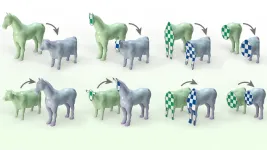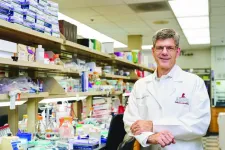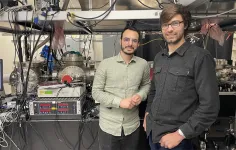(Press-News.org) CAMBRIDGE, MA — In computer graphics and computer-aided design (CAD), 3D objects are often represented by the contours of their outer surfaces. Computers store these shapes as “thin shells,” which model the contours of the skin of an animated character but not the flesh underneath.
This modeling decision makes it efficient to store and manipulate 3D shapes, but it can lead to unexpected artifacts. An animated character’s hand, for example, might crumple when bending its fingers — a motion that resembles how an empty rubber glove deforms rather than the motion of a hand filled with bones, tendons, and muscle. These differences are particularly problematic when developing mapping algorithms, which automatically find relationships between different shapes.
To address these shortcomings, researchers at MIT have developed an approach that aligns 3D shapes by mapping volumes to volumes, rather than surfaces to surfaces. Their technique represents shapes as tetrahedral meshes that include the mass inside a 3D object. Their algorithm determines how to move and stretch the corners of tetrahedra in a source shape so it aligns with a target shape.
Because it incorporates volumetric information, the researchers’ technique is better able to model fine parts of an object, avoiding the twisting and inversion typical of surface-based mapping.
“Switching from surfaces to volumes stretches the rubber glove over the whole hand. Our method brings geometric mapping closer to physical reality,” says Mazdak Abulnaga, an electrical engineering and computer science (EECS) graduate student who is lead author of the paper on this mapping technique.
The approach Abulnaga and his collaborators developed was able to align shapes more effectively than baseline methods, leading to high-quality shape maps with less distortion than competing alternatives. Their algorithm was especially well-suited for challenging mapping problems where the input shapes are geometrically distinct, such as mapping a smooth rabbit to LEGO-style rabbit made of cubes.
The technique could be useful in a number of graphics applications. For instance, it could be used to transfer the motions of a previously animated 3D character onto a new 3D model or scan. The same algorithm can transfer textures, annotations, and physical properties from one 3D shape to another, with applications not just in visual computing but also for computational manufacturing and engineering.
Joining Abulnaga on the paper are Oded Stein, a former MIT postdoc who is now on the faculty at the University of Southern California; Polina Golland, a Sunlin and Priscilla Chou Professor of EECS, a principal investigator in the MIT Computer Science and Artificial Intelligence Laboratory (CSAIL), and the leader of the Medical Vision Group; and Justin Solomon, an associate professor of EECS and the leader of the CSAIL Geometric Data Processing Group. The research will be presented at the ACM SIGGRAPH conference.
Shaping an algorithm
Abulnaga began this project by extending surface-based algorithms so they could map shapes volumetrically, but each attempt failed or produced implausible maps. The team quickly realized that new mathematics and algorithms were needed to tackle volume mapping.
Most mapping algorithms work by trying to minimize an “energy,” which quantifies how much a shape deforms when it is displaced, stretched, squashed, and sheared into another shape. These energies are often borrowed from physics, which uses similar equations to model the motion of elastic materials like gelatin.
Even when Abulnaga improved the energy in his mapping algorithm to better model volume physics, the method didn’t produce useful matchings. His team realized one reason for this failure is that many physical energies — and most mapping algorithms — lack symmetry.
In the new work, a symmetric method doesn’t care which order the shapes come in as input; there is no distinction between a “source” and “target” for the map. For example, mapping a horse onto a giraffe should produce the same matchings as mapping a giraffe onto a horse. But for many mapping algorithms, choosing the wrong shape to be the source or target leads to worse results. This effect is even more pronounced in the volumetric case.
Abulnaga documented how most mapping algorithms don’t use symmetric energies.
“If you choose the right energy for your algorithm, it can give you maps that are more realizable,” Abulnaga explains.
The typical energies used in shape alignment are only designed to map in one direction. If a researcher tries to apply them bidirectionally to create a symmetric map, the energies no longer behave as expected. These energies also behave differently when applied to surfaces and volumes.
Based on these findings, Abulnaga and his collaborators created a mathematical framework that researchers can use to see how different energies will behave and to determine which they should choose to create a symmetric map between two objects. Using this framework, they built a mapping algorithm that combines the energy functions for two objects in a way that guarantees symmetry throughout.
A user feeds the algorithm two shapes that are represented as tetrahedral meshes. Then the algorithm computes two bidirectional maps, from one shape to the other and back. These maps show where each corner of each tetrahedron should move to match the shapes.
“The energy is the cornerstone of this mapping process. The model tries to align the two shapes, and the energies prevent it from making unexpected alignments,” he says.
Achieving accurate alignments
When the researchers tested their approach, it created maps that better aligned shape pairs and which were higher quality and less distorted than other approaches that work on volumes. They also showed that using volume information can yield more accurate maps even when one is only concerned with the map of the outer surface.
However, there were some cases where their method fell short. For instance, the algorithm struggles when the shape alignment requires a great deal of volume changes, such as mapping a shape with a filled interior to one with a cavity inside.
In addition to addressing that limitation, the researchers want to continue optimizing the algorithm to reduce the amount of time it takes. The researchers are also working on extending this method to medical applications, bringing in MRI signals in addition to shape. This can help bridge the mapping approaches used in medical computer vision and computer graphics.
###
This research is funded, in part, by the National Institutes of Health, Wistron Corporation, the U.S. Army Research Office, the Air Force Office of Scientific Research, the National Science Foundation, the CSAIL Systems that Learn Program, the MIT-IBM Watson AI Lab, the Toyota-CSAIL Joint Research Center, Adobe Systems, the Swiss National Science Foundation, the Natural Sciences and Engineering Research Council of Canada, and a Mathworks Fellowship.
END
A better way to match 3D volumes
By mapping the volumes of objects, rather than their surfaces, a new technique could yield solutions to computer graphics problems in animation and CAD.
2023-05-24
ELSE PRESS RELEASES FROM THIS DATE:
Chemical Insights Research Institute and the Campus Safety, Health, and Environmental Management Association publish guidance for the safe use of 3D printing in institutions of higher education
2023-05-24
Atlanta (May 24, 2023) - Chemical Insights Research Institute (CIRI) of UL Research Institutes and the Campus Safety, Health, and Environmental Management Association (CSHEMA), announce the publication of, “UL 200B: Guidance Document for Safe Use of 3D Printing for Institutions of Higher Education.”
The availability of 3D printing has fostered creative and innovative learning experiences for many within the large population of students in higher education. There are roughly 17.3 million undergraduates in the U.S. alone. Because 3D printers are affordable compact, and user friendly, they can ...
SWI/SNF complexes “bookmark” cell identity during division
2023-05-24
(Memphis, Tenn.—May 24, 2023) When a cell divides, it retains information about how to grow and instructions about what type of cell to become. Scientists at St. Jude Children’s Research Hospital have gained a new understanding of how these processes can work, revealing a previously unappreciated role for the SWI/SNF chromatin remodeling complex. The study was published today in Nature.
When a cell undergoes differentiation, stem cells (the earliest cells that develop) undergo changes that transform them into a different type of cell, typically one with a more specialized function (such as a skin or muscle cell). As ...
Watching molecules relax in real time
2023-05-24
– By Rachel Berkowitz
Designing the next generation of efficient energy conversion devices for powering our electronics and heating our homes requires a detailed understanding of how molecules move and vibrate while undergoing light-induced chemical reactions. Researchers at the Department of Energy’s Lawrence Berkeley National Laboratory (Berkeley Lab) have now visualized the distortions of chemical bonds in a methane molecule after it absorbs light, loses an electron, and then relaxes. Their study provides insights into how molecules react to light, which can ultimately be useful for developing new methods ...
Announcing the Johnson & Johnson nursing innovation fellows
2023-05-24
PHILADELPHIA (May 24, 2023) – The University of Pennsylvania School of Nursing is pleased to announce that ten teams from health systems around the country have been selected for the Johnson & Johnson Nurse Innovation Fellowship Program (JJNIF), powered by Penn Nursing and the Wharton School–a ground-breaking, one-year, team-based nursing fellowship for Chief Nursing Officers, nurse executives, and senior nurse leaders.
The fellowship is unique in that two nurse leaders – one Chief Nursing Officer or nurse executive and one other senior ...
Tambourine announces the ALS breakthrough research fund, releases inaugural request for proposals
2023-05-24
Washington, DC (May 24) – Tambourine, in partnership with the Milken Institute Center for Strategic Philanthropy, today announced the ALS Breakthrough Research Fund and released the Fund’s first Request for Proposals (RFP). The Fund seeks to change how we understand and treat amyotrophic lateral sclerosis (ALS) by supporting innovative basic and discovery-focused research around the world. It particularly focuses on soliciting and funding creative, high-risk, high-reward ideas that might not otherwise fit existing grant programs but hold the potential to ...
MD Anderson Research Highlights for May 24, 2023
2023-05-24
HOUSTON ― The University of Texas MD Anderson Cancer Center’s Research Highlights showcases the latest breakthroughs in cancer care, research and prevention. These advances are made possible through seamless collaboration between MD Anderson’s world-leading clinicians and scientists, bringing discoveries from the lab to the clinic and back.
Recent developments include a new treatment option for relapsed/refractory mantle cell lymphoma, a better understanding of protein variants that trigger tumor cell death and activate ...
Study finds daily multivitamin supplements improved memory and slowed cognitive aging in older adults
2023-05-24
Few effective strategies have been shown in randomized clinical trials to improve memory or slow cognitive decline among older adults. Nutritional interventions may play an important role because the brain requires several nutrients for optimal health, and deficiencies in one or more of these nutrients may accelerate cognitive decline. The COcoa Supplement and Multivitamin Outcomes Study (COSMOS), a large-scale nation-wide randomized trial directed by researchers at Brigham and Women’s Hospital (BWH), a founding member of Mass General Brigham, included two separate clinical trials ...
New chemical compound demonstrates potential in nerve regeneration
2023-05-24
Research led by UCL, in partnership with the MRC Laboratory of Molecular Biology (MRC LMB) and AstraZeneca, has identified a new compound that can stimulate nerve regeneration after injury, as well as protect cardiac tissue from the sort of damage seen in heart attack.
The study, published in Nature, identified a chemical compound, named ‘1938’, that activates the PI3K signalling pathway, and is involved in cell growth. Results from this early research showed the compound increased neuron growth in nerve cells, and in animal models, it reduced heart tissue damage after major trauma and regenerated lost motor function in a model of nerve injury.
Though further research is ...
New research finds dramatic increase in illegal ketamine seized by authorities, sparking concern about potential dangers of rising recreational use
2023-05-24
A new analysis led by NYU Grossman School of Medicine and the National Drug Early Warning System (NDEWS) at the University of Florida found a 349 percent rise in seizures of illicit ketamine by drug enforcement throughout the United States from 2017 through 2022.
The study findings suggest that rising use of ketamine, a short-acting dissociative anesthetic commonly prescribed off-label to treat chronic pain and depression, can increase the likelihood that people who use recreationally or who use inadvertently may encounter an adulterated and potentially harmful version of the drug. The study publishes online May 24 in JAMA Psychiatry.
“This ...
COVID-19 and risk for mental disorders among adults in Denmark
2023-05-24
About The Study: In this Danish nationwide cohort study, overall risk of new-onset mental disorders in SARS-CoV-2–positive individuals did not exceed the risk among individuals with negative test results (except for those age 70 and older). However, when hospitalized, patients with COVID-19 had markedly increased risk compared with the general population, but comparable to risk among patients hospitalized for non–COVID-19 infections. Future studies should include even longer follow-up time and preferentially ...
LAST 30 PRESS RELEASES:
Injectable breast ‘implant’ offers alternative to traditional surgeries
Neuroscientists devise formulas to measure multilingualism
New prostate cancer trial seeks to reduce toxicity without sacrificing efficacy
Geometry shapes life
A CRISPR screen reveals many previously unrecognized genes required for brain development and a new neurodevelopmental disorder
Hot flush treatment has anti-breast cancer activity, study finds
Securing AI systems against growing cybersecurity threats
Longest observation of an active solar region
Why nail-biting, procrastination and other self-sabotaging behaviors are rooted in survival instincts
Regional variations in mechanical properties of porcine leptomeninges
Artificial empathy in therapy and healthcare: advancements in interpersonal interaction technologies
Why some brains switch gears more efficiently than others
UVA’s Jundong Li wins ICDM’S 2025 Tao Li Award for data mining, machine learning
UVA’s low-power, high-performance computer power player Mircea Stan earns National Academy of Inventors fellowship
Not playing by the rules: USU researcher explores filamentous algae dynamics in rivers
Do our body clocks influence our risk of dementia?
Anthropologists offer new evidence of bipedalism in long-debated fossil discovery
Safer receipt paper from wood
Dosage-sensitive genes suggest no whole-genome duplications in ancestral angiosperm
First ancient human herpesvirus genomes document their deep history with humans
Why Some Bacteria Survive Antibiotics and How to Stop Them - New study reveals that bacteria can survive antibiotic treatment through two fundamentally different “shutdown modes”
UCLA study links scar healing to dangerous placenta condition
CHANGE-seq-BE finds off-target changes in the genome from base editors
The Journal of Nuclear Medicine Ahead-of-Print Tip Sheet: January 2, 2026
Delayed or absent first dose of measles, mumps, and rubella vaccination
Trends in US preterm birth rates by household income and race and ethnicity
Study identifies potential biomarker linked to progression and brain inflammation in multiple sclerosis
Many mothers in Norway do not show up for postnatal check-ups
Researchers want to find out why quick clay is so unstable
Superradiant spins show teamwork at the quantum scale
[Press-News.org] A better way to match 3D volumesBy mapping the volumes of objects, rather than their surfaces, a new technique could yield solutions to computer graphics problems in animation and CAD.


